Analyzing Setup Reduction Techniques for Improved Business Performance
VerifiedAdded on 2023/02/01
|12
|2749
|89
Report
AI Summary
This report delves into setup reduction techniques, a crucial approach for lean deployment and optimizing business operations. It outlines the four key steps involved in setup reduction, illustrated with a case study of a crankshaft grinding firm. The report details the process of documenting setups, converting internal to external events, streamlining internal events, and eliminating adjustments. Furthermore, it highlights the significant benefits of setup reduction, including improved machine utilization, reduced lead times, and enhanced flexibility. The report also explores the impact of various lean tools, such as 5S, TPM, value stream mapping, and standardized work, on setup reduction times and overall performance. The conclusion emphasizes the importance of incorporating standardized work and waste management practices to further improve the production process and achieve total quality management. This report provides a comprehensive understanding of setup reduction and its positive impact on business development.
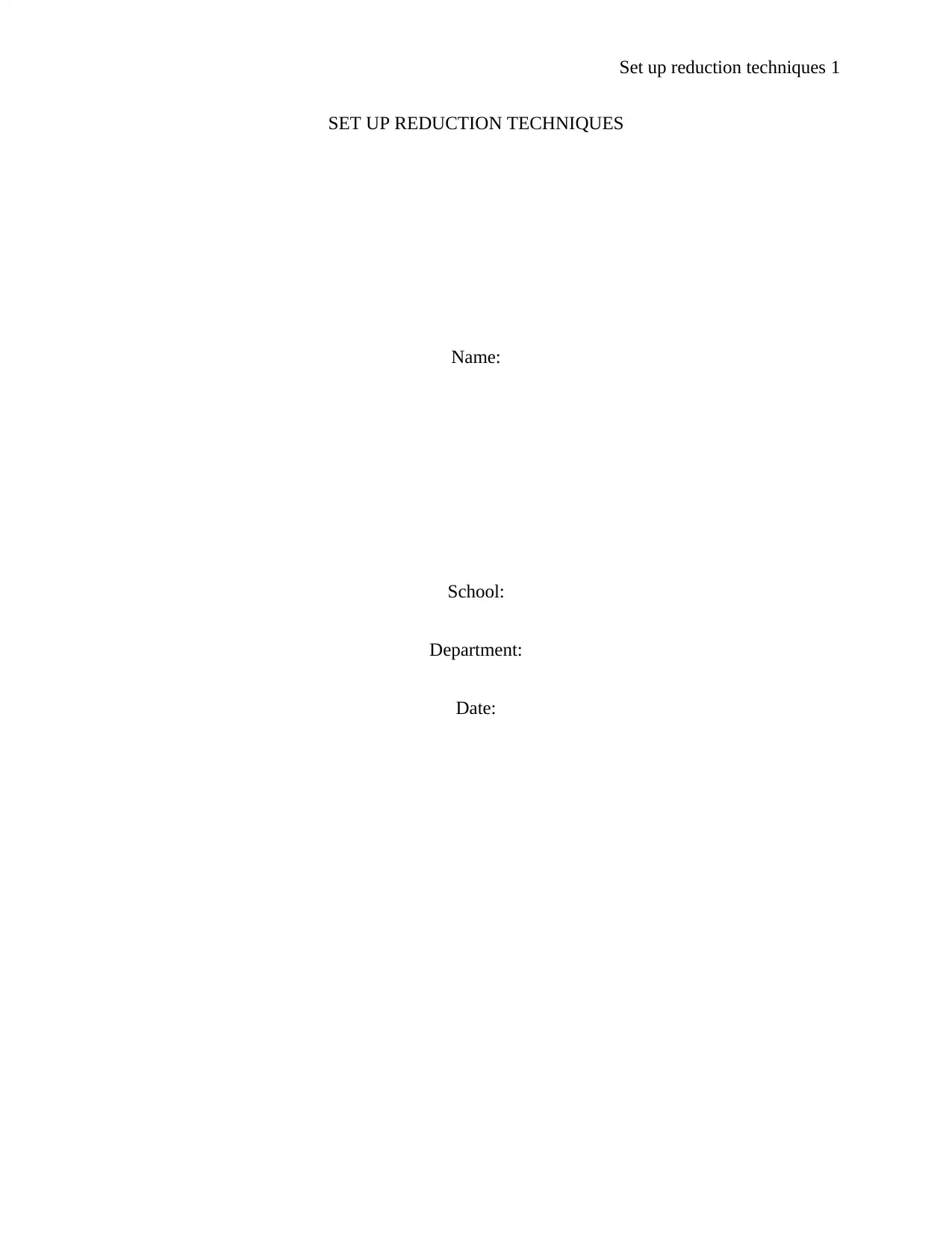
Set up reduction techniques 1
SET UP REDUCTION TECHNIQUES
Name:
School:
Department:
Date:
SET UP REDUCTION TECHNIQUES
Name:
School:
Department:
Date:
Paraphrase This Document
Need a fresh take? Get an instant paraphrase of this document with our AI Paraphraser
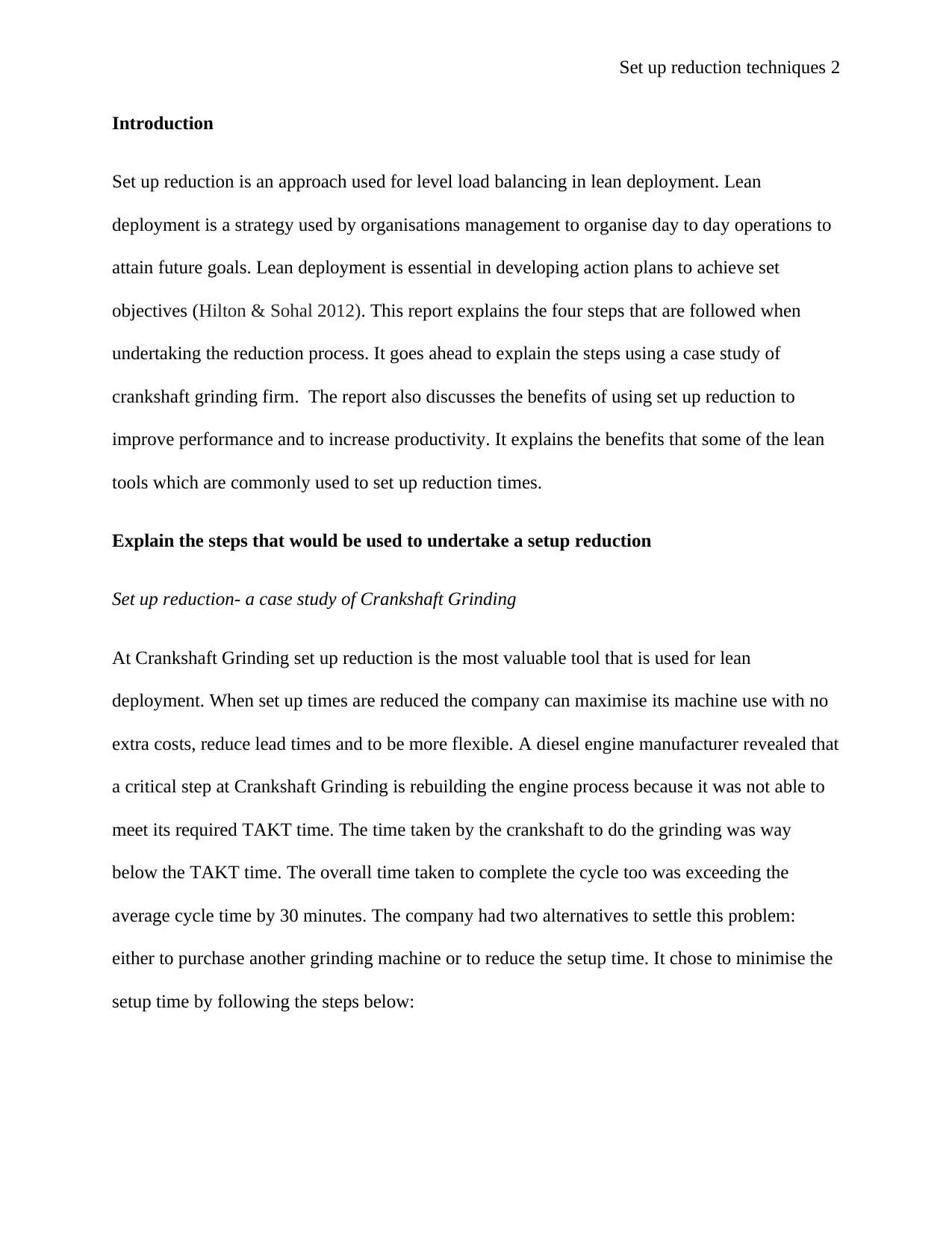
Set up reduction techniques 2
Introduction
Set up reduction is an approach used for level load balancing in lean deployment. Lean
deployment is a strategy used by organisations management to organise day to day operations to
attain future goals. Lean deployment is essential in developing action plans to achieve set
objectives (Hilton & Sohal 2012). This report explains the four steps that are followed when
undertaking the reduction process. It goes ahead to explain the steps using a case study of
crankshaft grinding firm. The report also discusses the benefits of using set up reduction to
improve performance and to increase productivity. It explains the benefits that some of the lean
tools which are commonly used to set up reduction times.
Explain the steps that would be used to undertake a setup reduction
Set up reduction- a case study of Crankshaft Grinding
At Crankshaft Grinding set up reduction is the most valuable tool that is used for lean
deployment. When set up times are reduced the company can maximise its machine use with no
extra costs, reduce lead times and to be more flexible. A diesel engine manufacturer revealed that
a critical step at Crankshaft Grinding is rebuilding the engine process because it was not able to
meet its required TAKT time. The time taken by the crankshaft to do the grinding was way
below the TAKT time. The overall time taken to complete the cycle too was exceeding the
average cycle time by 30 minutes. The company had two alternatives to settle this problem:
either to purchase another grinding machine or to reduce the setup time. It chose to minimise the
setup time by following the steps below:
Introduction
Set up reduction is an approach used for level load balancing in lean deployment. Lean
deployment is a strategy used by organisations management to organise day to day operations to
attain future goals. Lean deployment is essential in developing action plans to achieve set
objectives (Hilton & Sohal 2012). This report explains the four steps that are followed when
undertaking the reduction process. It goes ahead to explain the steps using a case study of
crankshaft grinding firm. The report also discusses the benefits of using set up reduction to
improve performance and to increase productivity. It explains the benefits that some of the lean
tools which are commonly used to set up reduction times.
Explain the steps that would be used to undertake a setup reduction
Set up reduction- a case study of Crankshaft Grinding
At Crankshaft Grinding set up reduction is the most valuable tool that is used for lean
deployment. When set up times are reduced the company can maximise its machine use with no
extra costs, reduce lead times and to be more flexible. A diesel engine manufacturer revealed that
a critical step at Crankshaft Grinding is rebuilding the engine process because it was not able to
meet its required TAKT time. The time taken by the crankshaft to do the grinding was way
below the TAKT time. The overall time taken to complete the cycle too was exceeding the
average cycle time by 30 minutes. The company had two alternatives to settle this problem:
either to purchase another grinding machine or to reduce the setup time. It chose to minimise the
setup time by following the steps below:
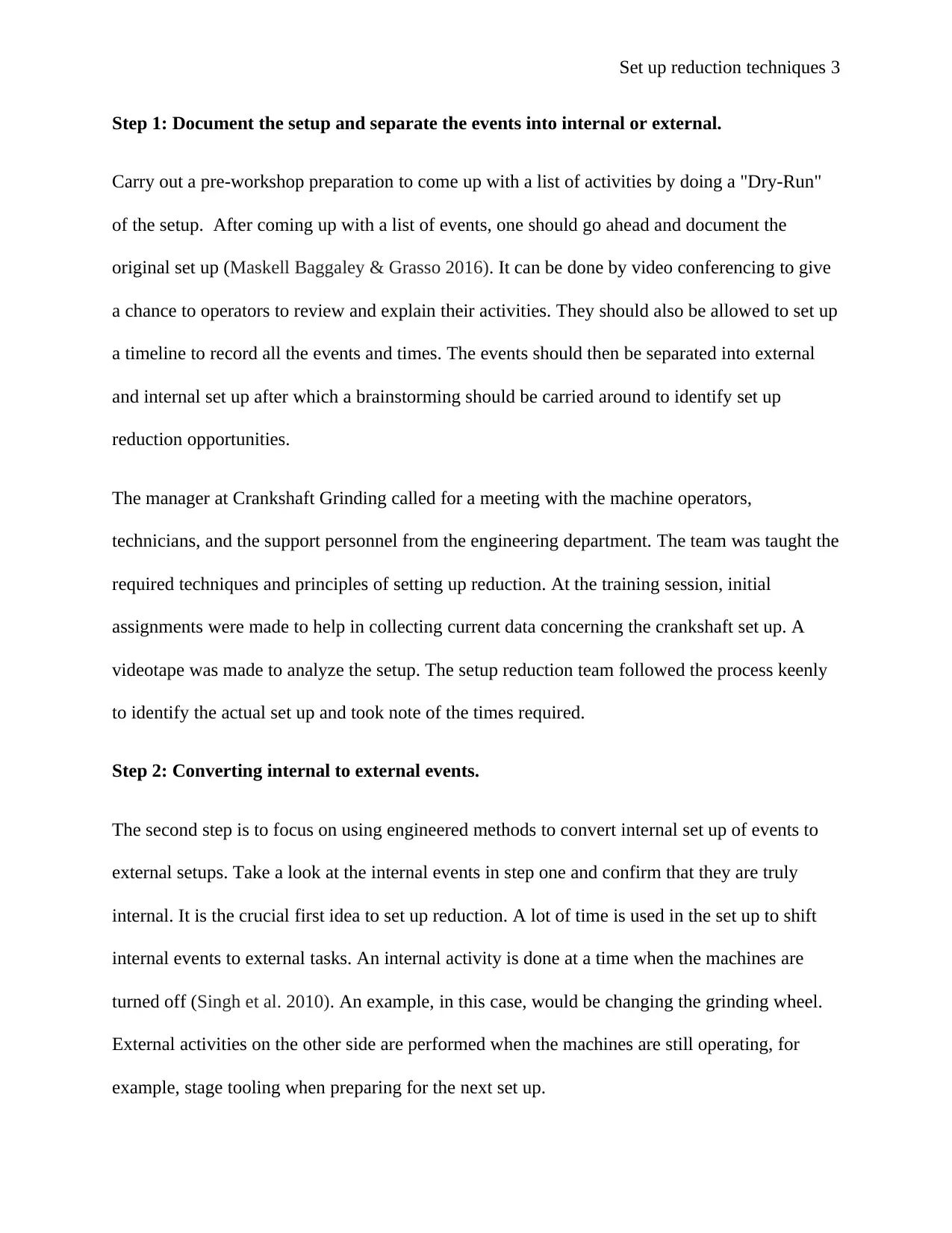
Set up reduction techniques 3
Step 1: Document the setup and separate the events into internal or external.
Carry out a pre-workshop preparation to come up with a list of activities by doing a "Dry-Run"
of the setup. After coming up with a list of events, one should go ahead and document the
original set up (Maskell Baggaley & Grasso 2016). It can be done by video conferencing to give
a chance to operators to review and explain their activities. They should also be allowed to set up
a timeline to record all the events and times. The events should then be separated into external
and internal set up after which a brainstorming should be carried around to identify set up
reduction opportunities.
The manager at Crankshaft Grinding called for a meeting with the machine operators,
technicians, and the support personnel from the engineering department. The team was taught the
required techniques and principles of setting up reduction. At the training session, initial
assignments were made to help in collecting current data concerning the crankshaft set up. A
videotape was made to analyze the setup. The setup reduction team followed the process keenly
to identify the actual set up and took note of the times required.
Step 2: Converting internal to external events.
The second step is to focus on using engineered methods to convert internal set up of events to
external setups. Take a look at the internal events in step one and confirm that they are truly
internal. It is the crucial first idea to set up reduction. A lot of time is used in the set up to shift
internal events to external tasks. An internal activity is done at a time when the machines are
turned off (Singh et al. 2010). An example, in this case, would be changing the grinding wheel.
External activities on the other side are performed when the machines are still operating, for
example, stage tooling when preparing for the next set up.
Step 1: Document the setup and separate the events into internal or external.
Carry out a pre-workshop preparation to come up with a list of activities by doing a "Dry-Run"
of the setup. After coming up with a list of events, one should go ahead and document the
original set up (Maskell Baggaley & Grasso 2016). It can be done by video conferencing to give
a chance to operators to review and explain their activities. They should also be allowed to set up
a timeline to record all the events and times. The events should then be separated into external
and internal set up after which a brainstorming should be carried around to identify set up
reduction opportunities.
The manager at Crankshaft Grinding called for a meeting with the machine operators,
technicians, and the support personnel from the engineering department. The team was taught the
required techniques and principles of setting up reduction. At the training session, initial
assignments were made to help in collecting current data concerning the crankshaft set up. A
videotape was made to analyze the setup. The setup reduction team followed the process keenly
to identify the actual set up and took note of the times required.
Step 2: Converting internal to external events.
The second step is to focus on using engineered methods to convert internal set up of events to
external setups. Take a look at the internal events in step one and confirm that they are truly
internal. It is the crucial first idea to set up reduction. A lot of time is used in the set up to shift
internal events to external tasks. An internal activity is done at a time when the machines are
turned off (Singh et al. 2010). An example, in this case, would be changing the grinding wheel.
External activities on the other side are performed when the machines are still operating, for
example, stage tooling when preparing for the next set up.
⊘ This is a preview!⊘
Do you want full access?
Subscribe today to unlock all pages.

Trusted by 1+ million students worldwide
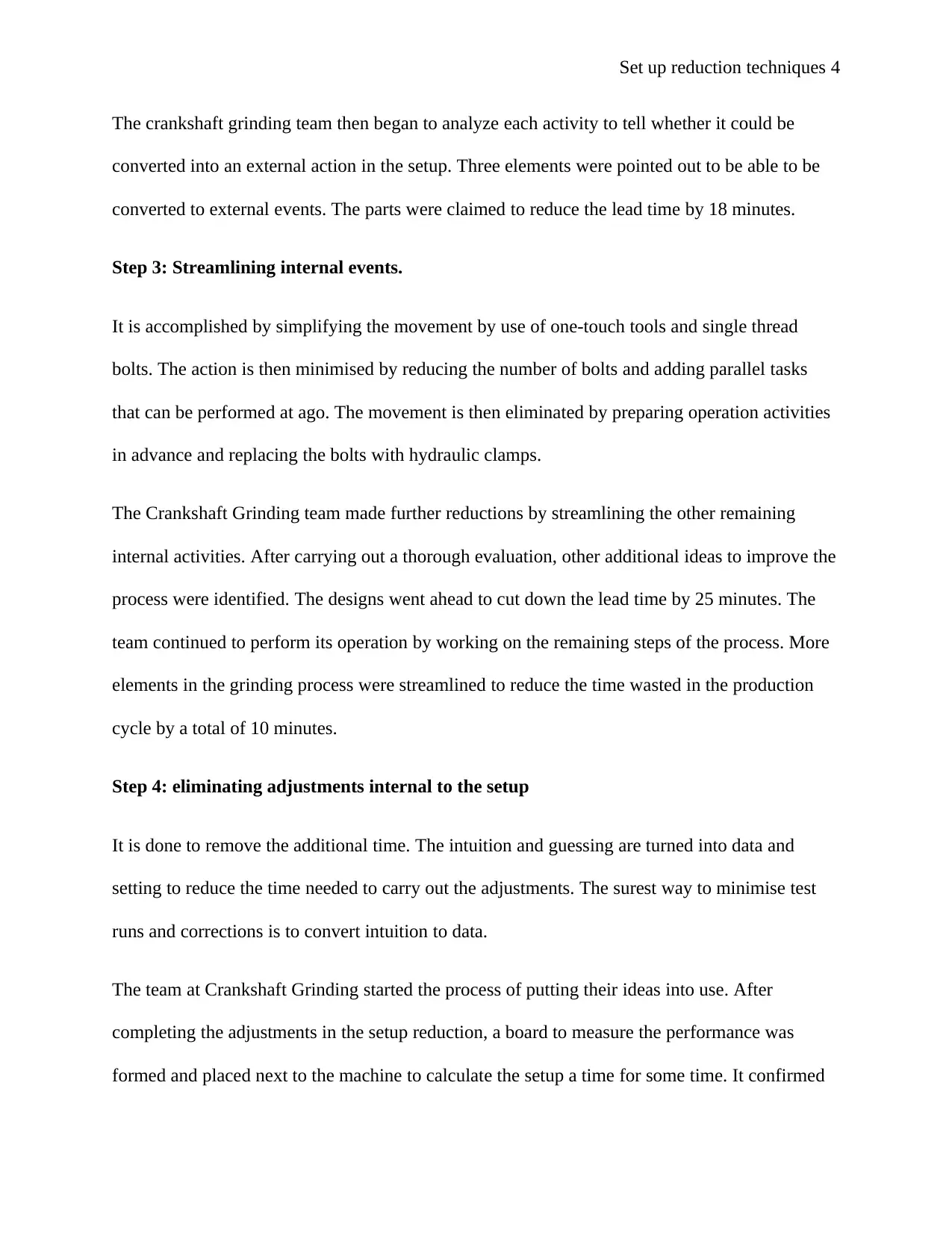
Set up reduction techniques 4
The crankshaft grinding team then began to analyze each activity to tell whether it could be
converted into an external action in the setup. Three elements were pointed out to be able to be
converted to external events. The parts were claimed to reduce the lead time by 18 minutes.
Step 3: Streamlining internal events.
It is accomplished by simplifying the movement by use of one-touch tools and single thread
bolts. The action is then minimised by reducing the number of bolts and adding parallel tasks
that can be performed at ago. The movement is then eliminated by preparing operation activities
in advance and replacing the bolts with hydraulic clamps.
The Crankshaft Grinding team made further reductions by streamlining the other remaining
internal activities. After carrying out a thorough evaluation, other additional ideas to improve the
process were identified. The designs went ahead to cut down the lead time by 25 minutes. The
team continued to perform its operation by working on the remaining steps of the process. More
elements in the grinding process were streamlined to reduce the time wasted in the production
cycle by a total of 10 minutes.
Step 4: eliminating adjustments internal to the setup
It is done to remove the additional time. The intuition and guessing are turned into data and
setting to reduce the time needed to carry out the adjustments. The surest way to minimise test
runs and corrections is to convert intuition to data.
The team at Crankshaft Grinding started the process of putting their ideas into use. After
completing the adjustments in the setup reduction, a board to measure the performance was
formed and placed next to the machine to calculate the setup a time for some time. It confirmed
The crankshaft grinding team then began to analyze each activity to tell whether it could be
converted into an external action in the setup. Three elements were pointed out to be able to be
converted to external events. The parts were claimed to reduce the lead time by 18 minutes.
Step 3: Streamlining internal events.
It is accomplished by simplifying the movement by use of one-touch tools and single thread
bolts. The action is then minimised by reducing the number of bolts and adding parallel tasks
that can be performed at ago. The movement is then eliminated by preparing operation activities
in advance and replacing the bolts with hydraulic clamps.
The Crankshaft Grinding team made further reductions by streamlining the other remaining
internal activities. After carrying out a thorough evaluation, other additional ideas to improve the
process were identified. The designs went ahead to cut down the lead time by 25 minutes. The
team continued to perform its operation by working on the remaining steps of the process. More
elements in the grinding process were streamlined to reduce the time wasted in the production
cycle by a total of 10 minutes.
Step 4: eliminating adjustments internal to the setup
It is done to remove the additional time. The intuition and guessing are turned into data and
setting to reduce the time needed to carry out the adjustments. The surest way to minimise test
runs and corrections is to convert intuition to data.
The team at Crankshaft Grinding started the process of putting their ideas into use. After
completing the adjustments in the setup reduction, a board to measure the performance was
formed and placed next to the machine to calculate the setup a time for some time. It confirmed
Paraphrase This Document
Need a fresh take? Get an instant paraphrase of this document with our AI Paraphraser
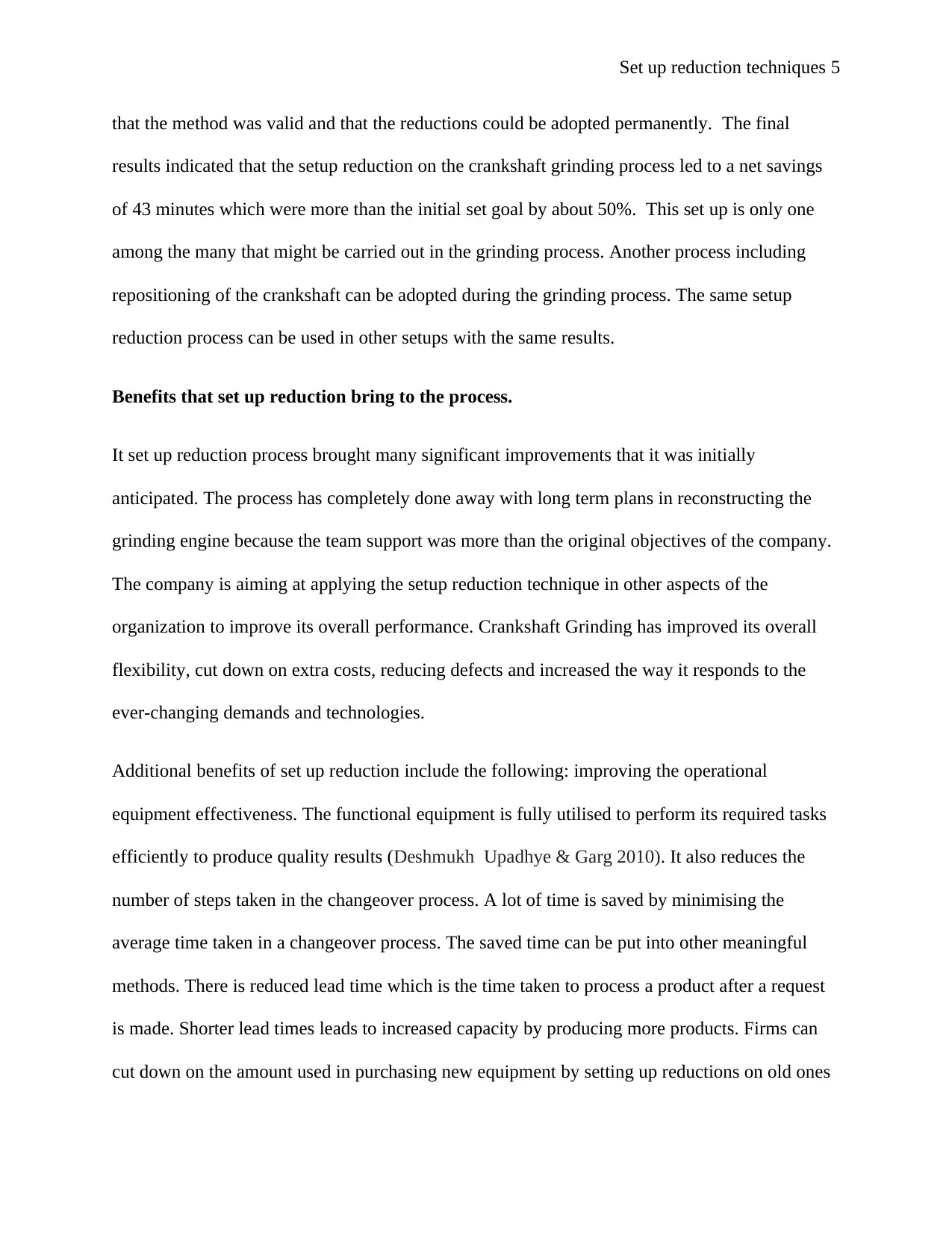
Set up reduction techniques 5
that the method was valid and that the reductions could be adopted permanently. The final
results indicated that the setup reduction on the crankshaft grinding process led to a net savings
of 43 minutes which were more than the initial set goal by about 50%. This set up is only one
among the many that might be carried out in the grinding process. Another process including
repositioning of the crankshaft can be adopted during the grinding process. The same setup
reduction process can be used in other setups with the same results.
Benefits that set up reduction bring to the process.
It set up reduction process brought many significant improvements that it was initially
anticipated. The process has completely done away with long term plans in reconstructing the
grinding engine because the team support was more than the original objectives of the company.
The company is aiming at applying the setup reduction technique in other aspects of the
organization to improve its overall performance. Crankshaft Grinding has improved its overall
flexibility, cut down on extra costs, reducing defects and increased the way it responds to the
ever-changing demands and technologies.
Additional benefits of set up reduction include the following: improving the operational
equipment effectiveness. The functional equipment is fully utilised to perform its required tasks
efficiently to produce quality results (Deshmukh Upadhye & Garg 2010). It also reduces the
number of steps taken in the changeover process. A lot of time is saved by minimising the
average time taken in a changeover process. The saved time can be put into other meaningful
methods. There is reduced lead time which is the time taken to process a product after a request
is made. Shorter lead times leads to increased capacity by producing more products. Firms can
cut down on the amount used in purchasing new equipment by setting up reductions on old ones
that the method was valid and that the reductions could be adopted permanently. The final
results indicated that the setup reduction on the crankshaft grinding process led to a net savings
of 43 minutes which were more than the initial set goal by about 50%. This set up is only one
among the many that might be carried out in the grinding process. Another process including
repositioning of the crankshaft can be adopted during the grinding process. The same setup
reduction process can be used in other setups with the same results.
Benefits that set up reduction bring to the process.
It set up reduction process brought many significant improvements that it was initially
anticipated. The process has completely done away with long term plans in reconstructing the
grinding engine because the team support was more than the original objectives of the company.
The company is aiming at applying the setup reduction technique in other aspects of the
organization to improve its overall performance. Crankshaft Grinding has improved its overall
flexibility, cut down on extra costs, reducing defects and increased the way it responds to the
ever-changing demands and technologies.
Additional benefits of set up reduction include the following: improving the operational
equipment effectiveness. The functional equipment is fully utilised to perform its required tasks
efficiently to produce quality results (Deshmukh Upadhye & Garg 2010). It also reduces the
number of steps taken in the changeover process. A lot of time is saved by minimising the
average time taken in a changeover process. The saved time can be put into other meaningful
methods. There is reduced lead time which is the time taken to process a product after a request
is made. Shorter lead times leads to increased capacity by producing more products. Firms can
cut down on the amount used in purchasing new equipment by setting up reductions on old ones
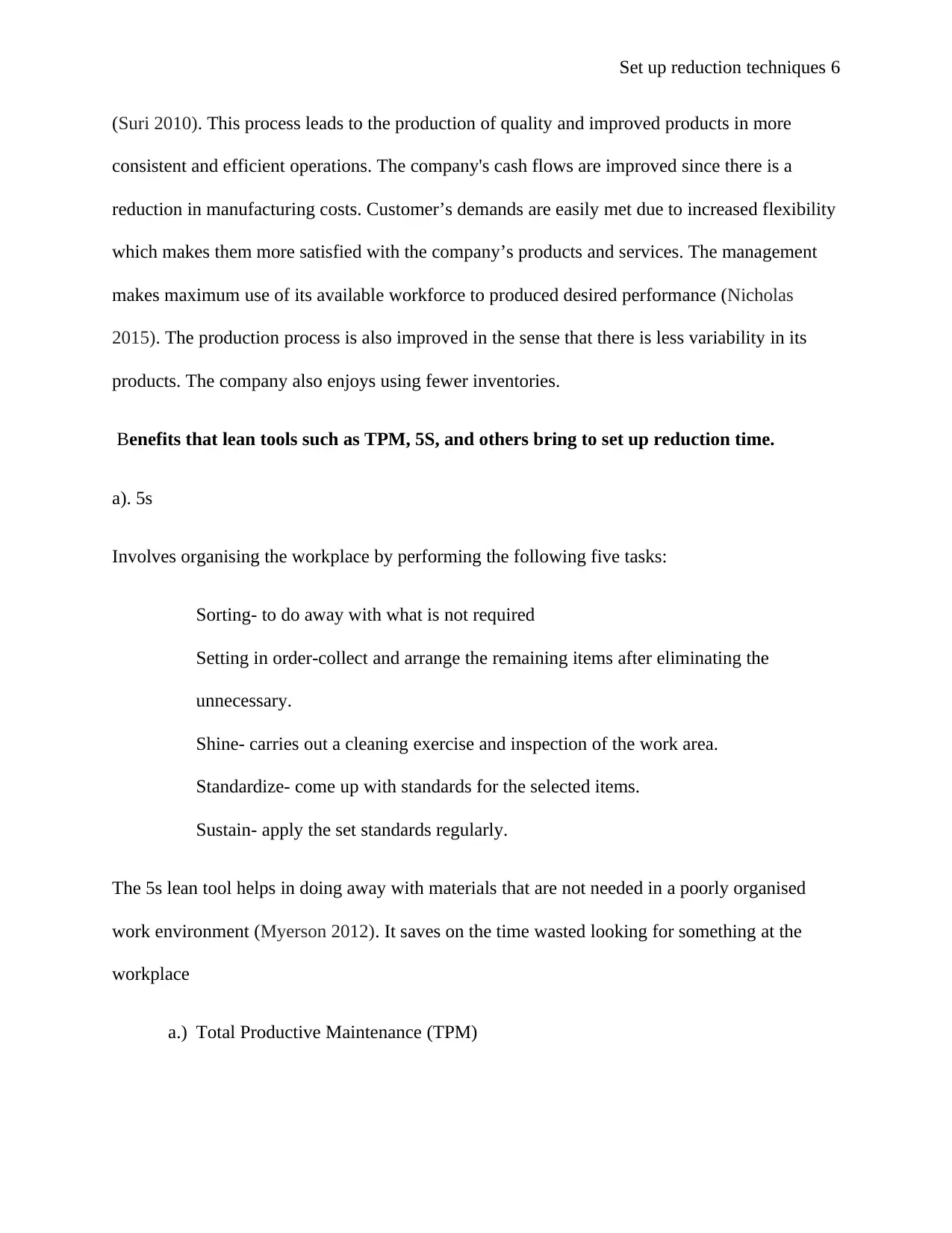
Set up reduction techniques 6
(Suri 2010). This process leads to the production of quality and improved products in more
consistent and efficient operations. The company's cash flows are improved since there is a
reduction in manufacturing costs. Customer’s demands are easily met due to increased flexibility
which makes them more satisfied with the company’s products and services. The management
makes maximum use of its available workforce to produced desired performance (Nicholas
2015). The production process is also improved in the sense that there is less variability in its
products. The company also enjoys using fewer inventories.
Benefits that lean tools such as TPM, 5S, and others bring to set up reduction time.
a). 5s
Involves organising the workplace by performing the following five tasks:
Sorting- to do away with what is not required
Setting in order-collect and arrange the remaining items after eliminating the
unnecessary.
Shine- carries out a cleaning exercise and inspection of the work area.
Standardize- come up with standards for the selected items.
Sustain- apply the set standards regularly.
The 5s lean tool helps in doing away with materials that are not needed in a poorly organised
work environment (Myerson 2012). It saves on the time wasted looking for something at the
workplace
a.) Total Productive Maintenance (TPM)
(Suri 2010). This process leads to the production of quality and improved products in more
consistent and efficient operations. The company's cash flows are improved since there is a
reduction in manufacturing costs. Customer’s demands are easily met due to increased flexibility
which makes them more satisfied with the company’s products and services. The management
makes maximum use of its available workforce to produced desired performance (Nicholas
2015). The production process is also improved in the sense that there is less variability in its
products. The company also enjoys using fewer inventories.
Benefits that lean tools such as TPM, 5S, and others bring to set up reduction time.
a). 5s
Involves organising the workplace by performing the following five tasks:
Sorting- to do away with what is not required
Setting in order-collect and arrange the remaining items after eliminating the
unnecessary.
Shine- carries out a cleaning exercise and inspection of the work area.
Standardize- come up with standards for the selected items.
Sustain- apply the set standards regularly.
The 5s lean tool helps in doing away with materials that are not needed in a poorly organised
work environment (Myerson 2012). It saves on the time wasted looking for something at the
workplace
a.) Total Productive Maintenance (TPM)
⊘ This is a preview!⊘
Do you want full access?
Subscribe today to unlock all pages.

Trusted by 1+ million students worldwide
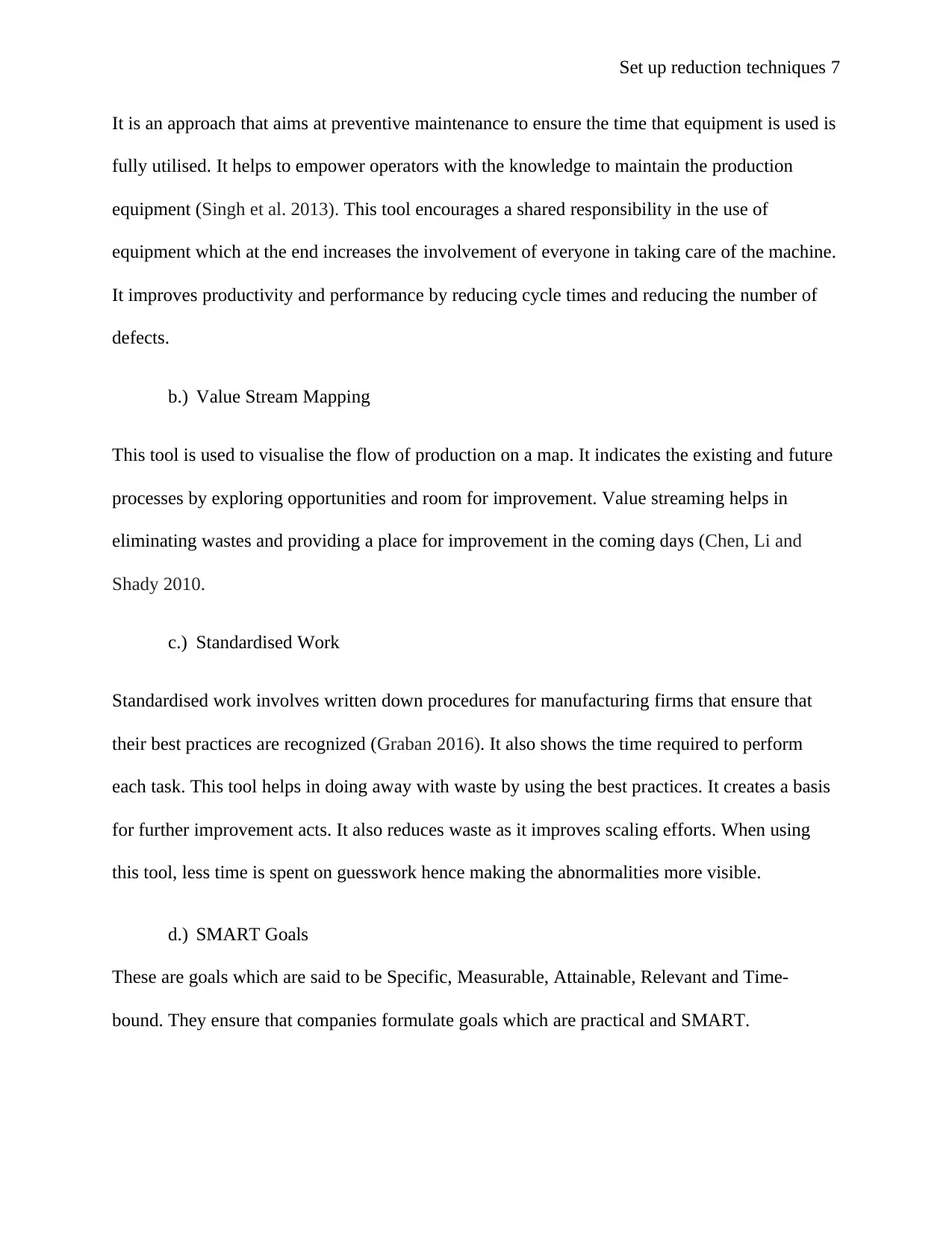
Set up reduction techniques 7
It is an approach that aims at preventive maintenance to ensure the time that equipment is used is
fully utilised. It helps to empower operators with the knowledge to maintain the production
equipment (Singh et al. 2013). This tool encourages a shared responsibility in the use of
equipment which at the end increases the involvement of everyone in taking care of the machine.
It improves productivity and performance by reducing cycle times and reducing the number of
defects.
b.) Value Stream Mapping
This tool is used to visualise the flow of production on a map. It indicates the existing and future
processes by exploring opportunities and room for improvement. Value streaming helps in
eliminating wastes and providing a place for improvement in the coming days (Chen, Li and
Shady 2010.
c.) Standardised Work
Standardised work involves written down procedures for manufacturing firms that ensure that
their best practices are recognized (Graban 2016). It also shows the time required to perform
each task. This tool helps in doing away with waste by using the best practices. It creates a basis
for further improvement acts. It also reduces waste as it improves scaling efforts. When using
this tool, less time is spent on guesswork hence making the abnormalities more visible.
d.) SMART Goals
These are goals which are said to be Specific, Measurable, Attainable, Relevant and Time-
bound. They ensure that companies formulate goals which are practical and SMART.
It is an approach that aims at preventive maintenance to ensure the time that equipment is used is
fully utilised. It helps to empower operators with the knowledge to maintain the production
equipment (Singh et al. 2013). This tool encourages a shared responsibility in the use of
equipment which at the end increases the involvement of everyone in taking care of the machine.
It improves productivity and performance by reducing cycle times and reducing the number of
defects.
b.) Value Stream Mapping
This tool is used to visualise the flow of production on a map. It indicates the existing and future
processes by exploring opportunities and room for improvement. Value streaming helps in
eliminating wastes and providing a place for improvement in the coming days (Chen, Li and
Shady 2010.
c.) Standardised Work
Standardised work involves written down procedures for manufacturing firms that ensure that
their best practices are recognized (Graban 2016). It also shows the time required to perform
each task. This tool helps in doing away with waste by using the best practices. It creates a basis
for further improvement acts. It also reduces waste as it improves scaling efforts. When using
this tool, less time is spent on guesswork hence making the abnormalities more visible.
d.) SMART Goals
These are goals which are said to be Specific, Measurable, Attainable, Relevant and Time-
bound. They ensure that companies formulate goals which are practical and SMART.
Paraphrase This Document
Need a fresh take? Get an instant paraphrase of this document with our AI Paraphraser
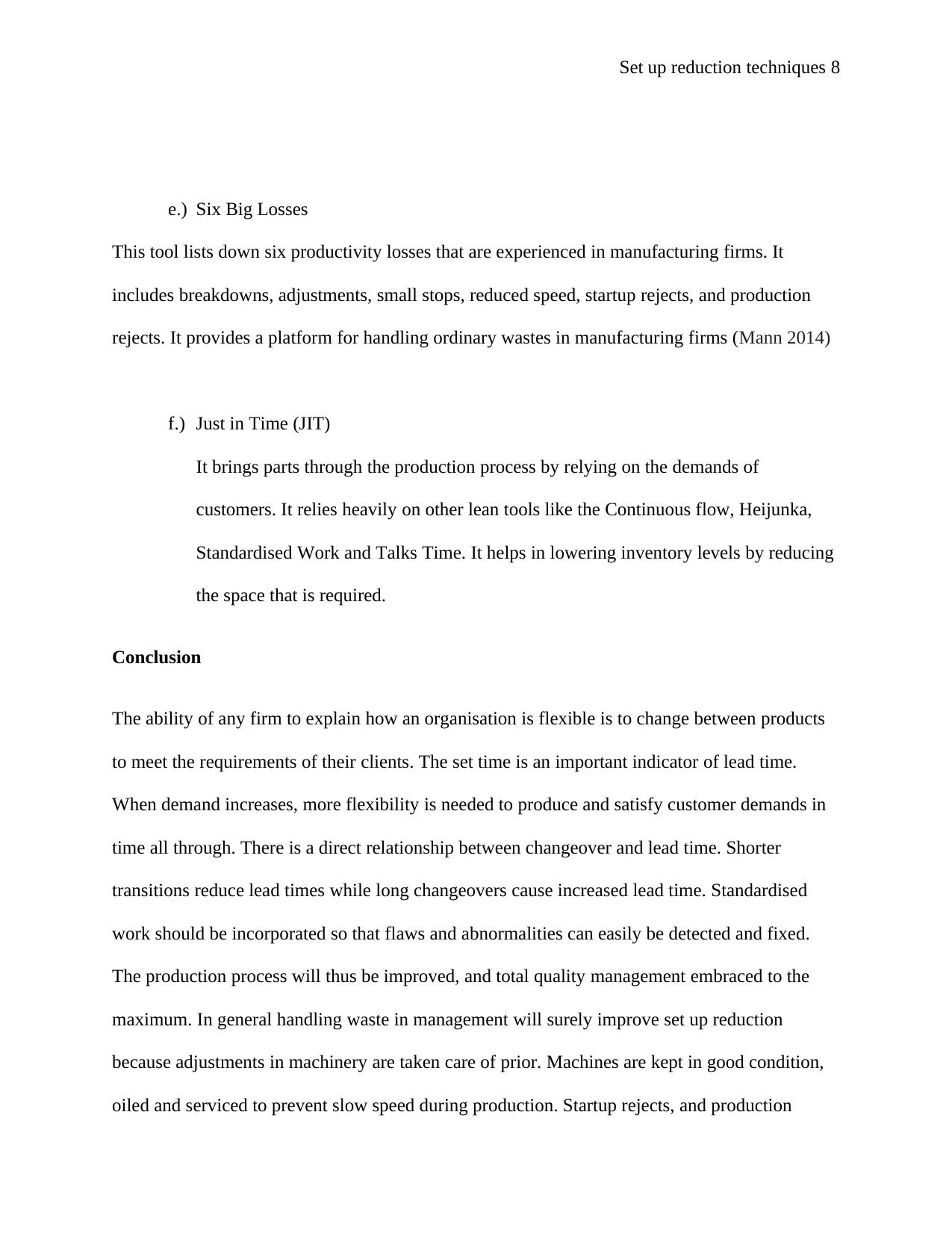
Set up reduction techniques 8
e.) Six Big Losses
This tool lists down six productivity losses that are experienced in manufacturing firms. It
includes breakdowns, adjustments, small stops, reduced speed, startup rejects, and production
rejects. It provides a platform for handling ordinary wastes in manufacturing firms (Mann 2014)
f.) Just in Time (JIT)
It brings parts through the production process by relying on the demands of
customers. It relies heavily on other lean tools like the Continuous flow, Heijunka,
Standardised Work and Talks Time. It helps in lowering inventory levels by reducing
the space that is required.
Conclusion
The ability of any firm to explain how an organisation is flexible is to change between products
to meet the requirements of their clients. The set time is an important indicator of lead time.
When demand increases, more flexibility is needed to produce and satisfy customer demands in
time all through. There is a direct relationship between changeover and lead time. Shorter
transitions reduce lead times while long changeovers cause increased lead time. Standardised
work should be incorporated so that flaws and abnormalities can easily be detected and fixed.
The production process will thus be improved, and total quality management embraced to the
maximum. In general handling waste in management will surely improve set up reduction
because adjustments in machinery are taken care of prior. Machines are kept in good condition,
oiled and serviced to prevent slow speed during production. Startup rejects, and production
e.) Six Big Losses
This tool lists down six productivity losses that are experienced in manufacturing firms. It
includes breakdowns, adjustments, small stops, reduced speed, startup rejects, and production
rejects. It provides a platform for handling ordinary wastes in manufacturing firms (Mann 2014)
f.) Just in Time (JIT)
It brings parts through the production process by relying on the demands of
customers. It relies heavily on other lean tools like the Continuous flow, Heijunka,
Standardised Work and Talks Time. It helps in lowering inventory levels by reducing
the space that is required.
Conclusion
The ability of any firm to explain how an organisation is flexible is to change between products
to meet the requirements of their clients. The set time is an important indicator of lead time.
When demand increases, more flexibility is needed to produce and satisfy customer demands in
time all through. There is a direct relationship between changeover and lead time. Shorter
transitions reduce lead times while long changeovers cause increased lead time. Standardised
work should be incorporated so that flaws and abnormalities can easily be detected and fixed.
The production process will thus be improved, and total quality management embraced to the
maximum. In general handling waste in management will surely improve set up reduction
because adjustments in machinery are taken care of prior. Machines are kept in good condition,
oiled and serviced to prevent slow speed during production. Startup rejects, and production
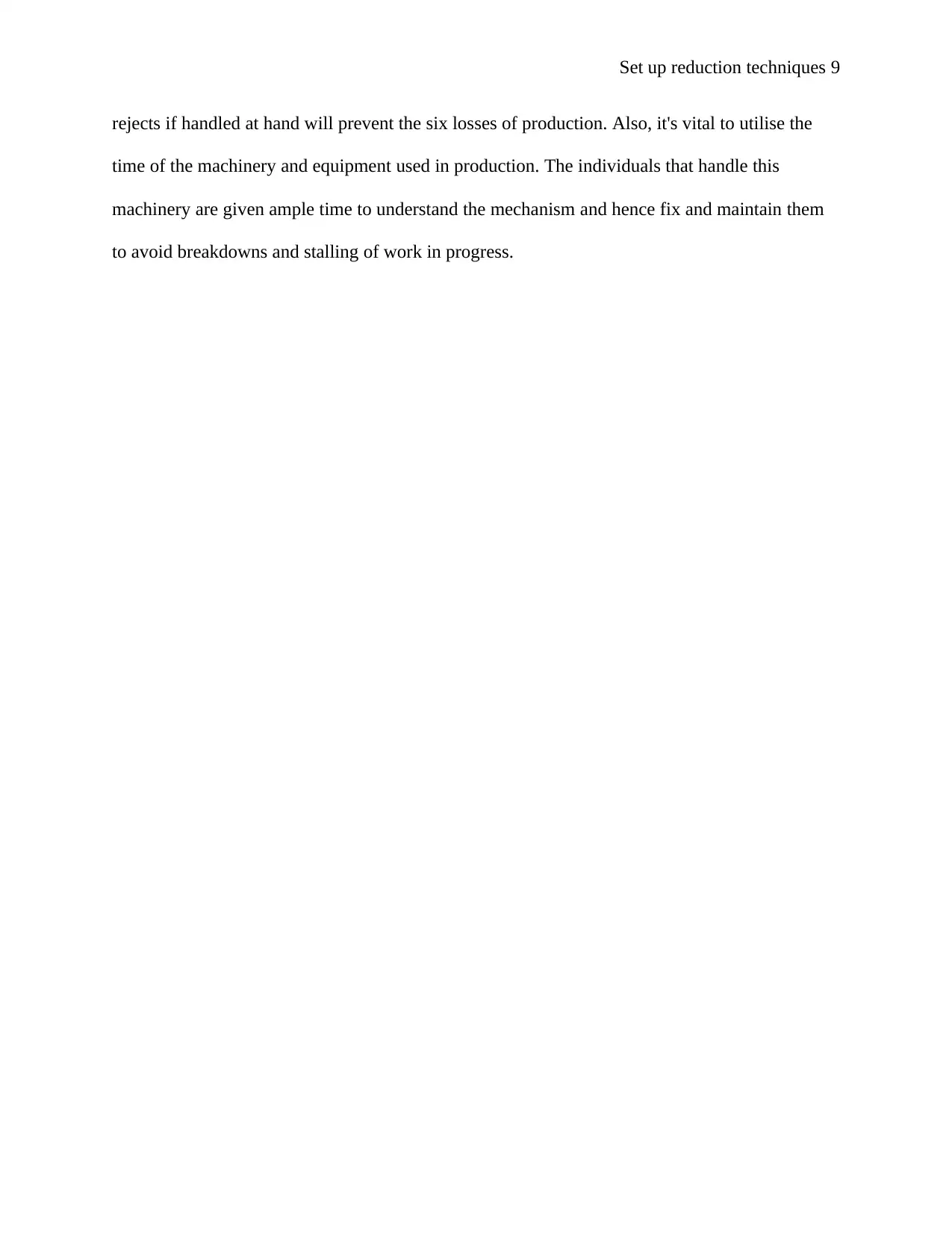
Set up reduction techniques 9
rejects if handled at hand will prevent the six losses of production. Also, it's vital to utilise the
time of the machinery and equipment used in production. The individuals that handle this
machinery are given ample time to understand the mechanism and hence fix and maintain them
to avoid breakdowns and stalling of work in progress.
rejects if handled at hand will prevent the six losses of production. Also, it's vital to utilise the
time of the machinery and equipment used in production. The individuals that handle this
machinery are given ample time to understand the mechanism and hence fix and maintain them
to avoid breakdowns and stalling of work in progress.
⊘ This is a preview!⊘
Do you want full access?
Subscribe today to unlock all pages.

Trusted by 1+ million students worldwide
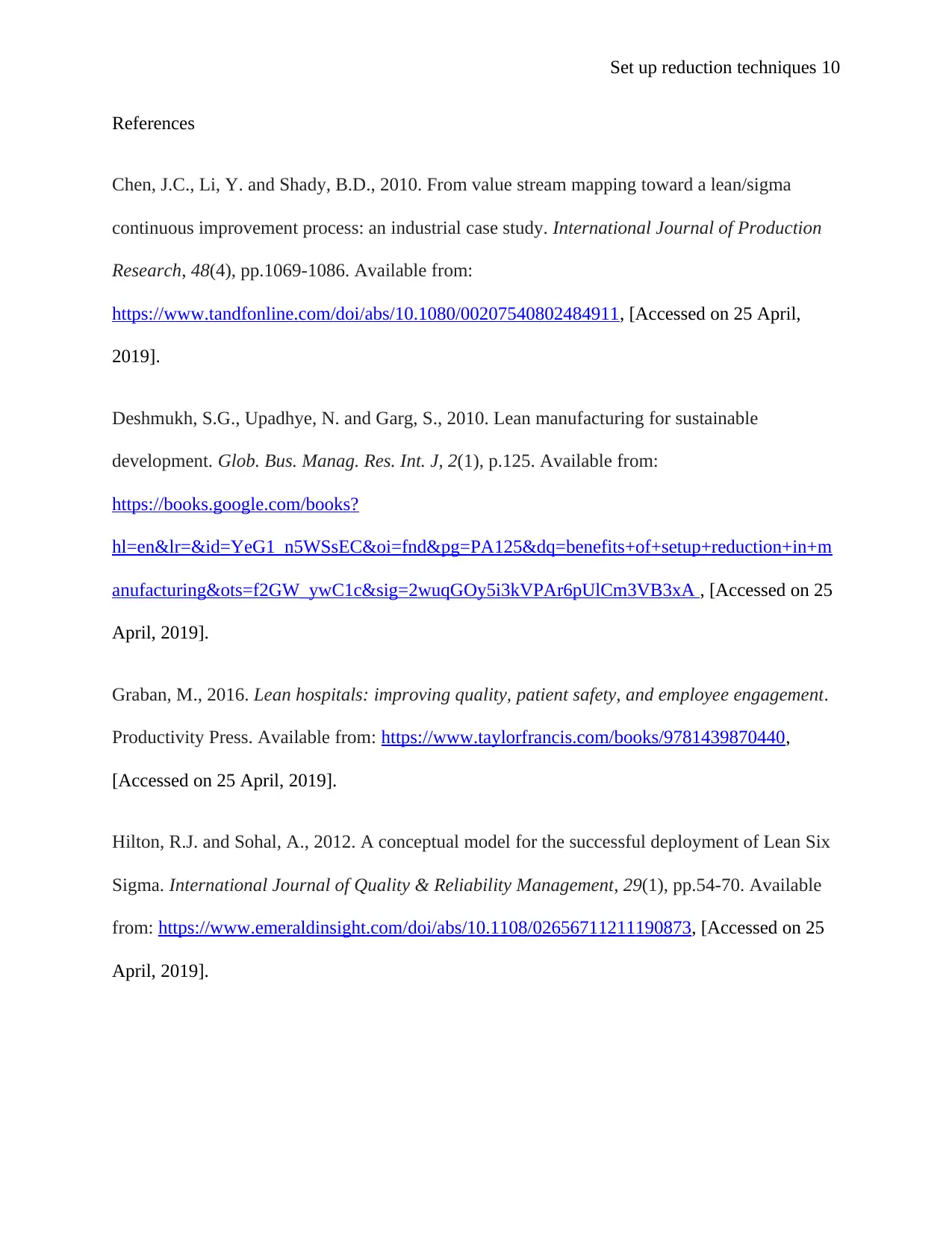
Set up reduction techniques 10
References
Chen, J.C., Li, Y. and Shady, B.D., 2010. From value stream mapping toward a lean/sigma
continuous improvement process: an industrial case study. International Journal of Production
Research, 48(4), pp.1069-1086. Available from:
https://www.tandfonline.com/doi/abs/10.1080/00207540802484911, [Accessed on 25 April,
2019].
Deshmukh, S.G., Upadhye, N. and Garg, S., 2010. Lean manufacturing for sustainable
development. Glob. Bus. Manag. Res. Int. J, 2(1), p.125. Available from:
https://books.google.com/books?
hl=en&lr=&id=YeG1_n5WSsEC&oi=fnd&pg=PA125&dq=benefits+of+setup+reduction+in+m
anufacturing&ots=f2GW_ywC1c&sig=2wuqGOy5i3kVPAr6pUlCm3VB3xA , [Accessed on 25
April, 2019].
Graban, M., 2016. Lean hospitals: improving quality, patient safety, and employee engagement.
Productivity Press. Available from: https://www.taylorfrancis.com/books/9781439870440,
[Accessed on 25 April, 2019].
Hilton, R.J. and Sohal, A., 2012. A conceptual model for the successful deployment of Lean Six
Sigma. International Journal of Quality & Reliability Management, 29(1), pp.54-70. Available
from: https://www.emeraldinsight.com/doi/abs/10.1108/02656711211190873, [Accessed on 25
April, 2019].
References
Chen, J.C., Li, Y. and Shady, B.D., 2010. From value stream mapping toward a lean/sigma
continuous improvement process: an industrial case study. International Journal of Production
Research, 48(4), pp.1069-1086. Available from:
https://www.tandfonline.com/doi/abs/10.1080/00207540802484911, [Accessed on 25 April,
2019].
Deshmukh, S.G., Upadhye, N. and Garg, S., 2010. Lean manufacturing for sustainable
development. Glob. Bus. Manag. Res. Int. J, 2(1), p.125. Available from:
https://books.google.com/books?
hl=en&lr=&id=YeG1_n5WSsEC&oi=fnd&pg=PA125&dq=benefits+of+setup+reduction+in+m
anufacturing&ots=f2GW_ywC1c&sig=2wuqGOy5i3kVPAr6pUlCm3VB3xA , [Accessed on 25
April, 2019].
Graban, M., 2016. Lean hospitals: improving quality, patient safety, and employee engagement.
Productivity Press. Available from: https://www.taylorfrancis.com/books/9781439870440,
[Accessed on 25 April, 2019].
Hilton, R.J. and Sohal, A., 2012. A conceptual model for the successful deployment of Lean Six
Sigma. International Journal of Quality & Reliability Management, 29(1), pp.54-70. Available
from: https://www.emeraldinsight.com/doi/abs/10.1108/02656711211190873, [Accessed on 25
April, 2019].
Paraphrase This Document
Need a fresh take? Get an instant paraphrase of this document with our AI Paraphraser
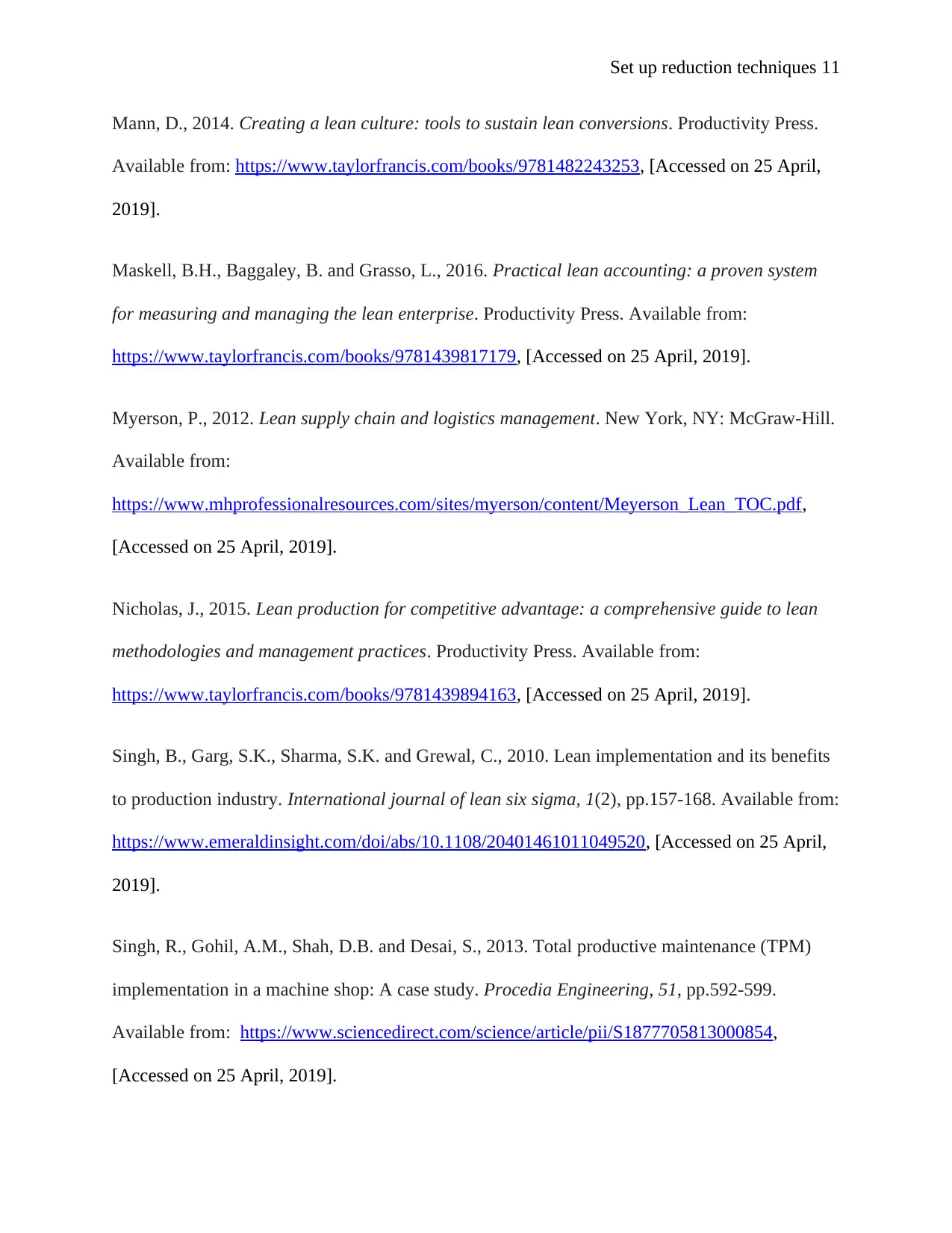
Set up reduction techniques 11
Mann, D., 2014. Creating a lean culture: tools to sustain lean conversions. Productivity Press.
Available from: https://www.taylorfrancis.com/books/9781482243253, [Accessed on 25 April,
2019].
Maskell, B.H., Baggaley, B. and Grasso, L., 2016. Practical lean accounting: a proven system
for measuring and managing the lean enterprise. Productivity Press. Available from:
https://www.taylorfrancis.com/books/9781439817179, [Accessed on 25 April, 2019].
Myerson, P., 2012. Lean supply chain and logistics management. New York, NY: McGraw-Hill.
Available from:
https://www.mhprofessionalresources.com/sites/myerson/content/Meyerson_Lean_TOC.pdf,
[Accessed on 25 April, 2019].
Nicholas, J., 2015. Lean production for competitive advantage: a comprehensive guide to lean
methodologies and management practices. Productivity Press. Available from:
https://www.taylorfrancis.com/books/9781439894163, [Accessed on 25 April, 2019].
Singh, B., Garg, S.K., Sharma, S.K. and Grewal, C., 2010. Lean implementation and its benefits
to production industry. International journal of lean six sigma, 1(2), pp.157-168. Available from:
https://www.emeraldinsight.com/doi/abs/10.1108/20401461011049520, [Accessed on 25 April,
2019].
Singh, R., Gohil, A.M., Shah, D.B. and Desai, S., 2013. Total productive maintenance (TPM)
implementation in a machine shop: A case study. Procedia Engineering, 51, pp.592-599.
Available from: https://www.sciencedirect.com/science/article/pii/S1877705813000854,
[Accessed on 25 April, 2019].
Mann, D., 2014. Creating a lean culture: tools to sustain lean conversions. Productivity Press.
Available from: https://www.taylorfrancis.com/books/9781482243253, [Accessed on 25 April,
2019].
Maskell, B.H., Baggaley, B. and Grasso, L., 2016. Practical lean accounting: a proven system
for measuring and managing the lean enterprise. Productivity Press. Available from:
https://www.taylorfrancis.com/books/9781439817179, [Accessed on 25 April, 2019].
Myerson, P., 2012. Lean supply chain and logistics management. New York, NY: McGraw-Hill.
Available from:
https://www.mhprofessionalresources.com/sites/myerson/content/Meyerson_Lean_TOC.pdf,
[Accessed on 25 April, 2019].
Nicholas, J., 2015. Lean production for competitive advantage: a comprehensive guide to lean
methodologies and management practices. Productivity Press. Available from:
https://www.taylorfrancis.com/books/9781439894163, [Accessed on 25 April, 2019].
Singh, B., Garg, S.K., Sharma, S.K. and Grewal, C., 2010. Lean implementation and its benefits
to production industry. International journal of lean six sigma, 1(2), pp.157-168. Available from:
https://www.emeraldinsight.com/doi/abs/10.1108/20401461011049520, [Accessed on 25 April,
2019].
Singh, R., Gohil, A.M., Shah, D.B. and Desai, S., 2013. Total productive maintenance (TPM)
implementation in a machine shop: A case study. Procedia Engineering, 51, pp.592-599.
Available from: https://www.sciencedirect.com/science/article/pii/S1877705813000854,
[Accessed on 25 April, 2019].
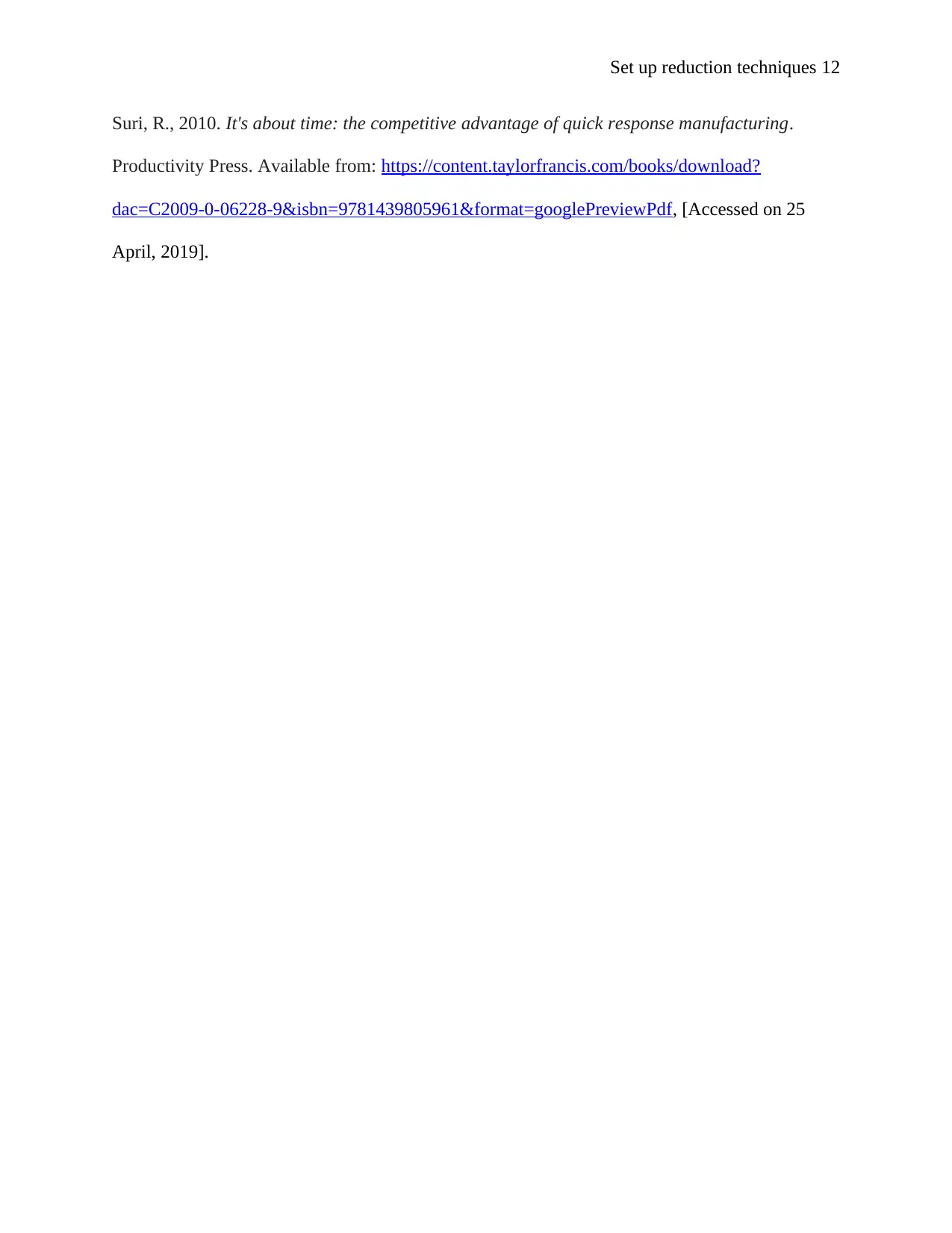
Set up reduction techniques 12
Suri, R., 2010. It's about time: the competitive advantage of quick response manufacturing.
Productivity Press. Available from: https://content.taylorfrancis.com/books/download?
dac=C2009-0-06228-9&isbn=9781439805961&format=googlePreviewPdf, [Accessed on 25
April, 2019].
Suri, R., 2010. It's about time: the competitive advantage of quick response manufacturing.
Productivity Press. Available from: https://content.taylorfrancis.com/books/download?
dac=C2009-0-06228-9&isbn=9781439805961&format=googlePreviewPdf, [Accessed on 25
April, 2019].
⊘ This is a preview!⊘
Do you want full access?
Subscribe today to unlock all pages.

Trusted by 1+ million students worldwide
1 out of 12
Your All-in-One AI-Powered Toolkit for Academic Success.
+13062052269
info@desklib.com
Available 24*7 on WhatsApp / Email
![[object Object]](/_next/static/media/star-bottom.7253800d.svg)
Unlock your academic potential
Copyright © 2020–2025 A2Z Services. All Rights Reserved. Developed and managed by ZUCOL.


